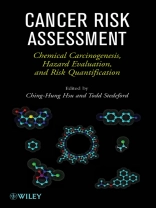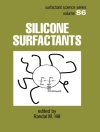With a weight-of-the-evidence approach, cancer risk assessment indentifies hazards, determines dose-response relationships, and assesses exposure to characterize the true risk. This book focuses on the quantitative methods for conducting chemical cancer risk assessments for solvents, metals, mixtures, and nanoparticles. It links these to the basic toxicology and biology of cancer, along with the impacts on regulatory guidelines and standards. By providing insightful perspective, Cancer Risk Assessment helps researchers develop a discriminate eye when it comes to interpreting data accurately and separating relevant information from erroneous.
Innehållsförteckning
Contributors.
Preface.
SECTION I. CANCER RISK ASSESSMENT, SCIENCE POLICY, AND REGULATORY.
FRAMEWORKS.
1. Cancer Risk Assessment (Elizabeth L. Anderson, Kimberly Lowe, and Paul Turnham).
2. Science Policy and Cancer Risk Assessment (Gary E. Marchant).
3. Hazard and Risk Assessment of Chemical Carcinogenicity within a Regulatory Context (Henk Tennekes, Virginia A. Gretton, and Todd Stedeford).
4. Use of Cancer Risk Assessments in Determination of Regulatory Standards (Robert A. Howd and Anna M. Fan).
SECTION II. CANCER BIOLOGY AND TOXICOLOGY.
5. The Interplay of Cancer and Biology (James W. Holder).
6. Chemical Carcinogenesis: A Brief History of its Concepts with a Focus on Polycyclic Aromatic Hydrocarbons (Stephen Nesnow).
7. Hormesis and Cancer Risks: Issues and Resolution (Paolo F. Ricci and Edward J. Calabrese).
8. Thresholds for Genotoxic Carcinogens: Evidence from Mechanism-Based.
Carcinogenicity Studies (Shoji Fukushima, Min Wei, Anna Kakehashi, and Hideki Wanibuchi).
SECTION III. GENETIC TOXICOLOGY, TESTING GUIDELINES AND REGULATIONS, AND NOVEL ASSAYS.
9. Development of Genetic Toxicology Testing and its Incorporation into Regulatory Health Effects Test Requirements (Errol Zeiger).
10. Genetic Toxicology Testing Guidelines and Regulations (Lutz Müller and Hansjörg Martus).
11. In Vitro Genetox Assays (David Kirkland and David Gatehouse).
12. In Vivo Genetox Assays and Transgenic mutation models (Véronique Thybaud).
SECTION IV. ASSESSING THE HUMAN RELEVANCE OF CHEMICAL-INDUCED TUMORS.
13. Framework Analysis for Determining Mode of Action and Human Relevance (R. Julian Preston).
14. Experimental Animal Studies and Carcinogenicity (Bette Meek).
15. Cancer Epidemiology (Herman J. Gibb and Jessie P. Buckley).
16. Rodent Hepatocarcinogenesis (James E. Klaunig).
17. Mode of Action Analysis and Human Relevance of Liver Tumors Induced by PPAR-alpha Activation (J. Christopher Corton).
18. Alpha2u-globulin-Nephropathy and Chronic Progressive Nephropathy.
as Modes of Action for Renal Tubule Tumour Induction in Rats, and their Possible Interaction (Edward A. Lock and Gordon C. Hard).
19. Urinary Tract Calculi and Bladder Tumors (Samuel M. Cohen, Lora L. Arnold, and Shugo Suzuki).
SECTION V. METHODS FOR INFORMING CANCER RISK QUANTIFICATION.
20. Quantitative Structure-Activity Relationship (QSAR) Analysis of Genotoxic and Nongenotoxic carcinogens: A State-of-the-art overview (Yin-tak Woo and David Y. Lai).
21. Physiologically-Based Pharmacokinetic (PBPK) Models in Cancer Risk.
Assessment (Mathieu Valcke and Kannan Krishnan).
22. Omics and Its Role in Cancer Risk Assessment (Banalata Sen, Douglas C. Wolf, and Vicki Dellarco).
23. Computational Toxicology in Cancer Risk Assessment (Jerry Blancato).
SECTION VI. GENERAL APPROACHES FOR QUANTIFYING CANCER RISKS.
24. Linear Low-Dose Extrapolations (Michael Dourson and Lynne Haber).
25. Quantitative Cancer Risk Assessment of Nongenotoxic Carcinogens (Rafael Meza, Jihyoun Jeon, and Suresh H. Moolgavkar).
26. Nonlinear Low-Dose Extrapolations (Ari S. Lewis and Babara Beck).
27. Cancer Risk Assessment: More Uncertain than We Thought (Edmund A.C. Crouch).
28. Combining Neoplasms for Evaluation of Rodent Carcinogenesis Studies (Amy E. Brix, Jerry F. Hardisty, and Ernest E. Mc Connell).
29. Cancer Risk Based on an Individual Tumor Type or Summing of Tumors (Andrew G. Salmon and Lindsey A. Roth).
30. Exposure Reconstruction and Cancer Risk Estimate Derivation (Shannon H. Gaffney, Jennifer Sahmel, Kathryn D. Devlin, and Dennis J. Paustenbach).
Abbreviations and Acronyms.
Index.
Om författaren
CHING-HUNG HSU, Ph D, DABT, is a Vice President at Tai Gen
Biotechnology Co., Ltd. His professional experience includes
positions at Merck & Co., Inc., the U.S. Environmental
Protection Agency, and the California Environmental Protection
Agency. Dr. Hsu earned his BS from the National Taiwan University
and Ph D from the Massachusetts Institute of Technology. He
completed his postdoctoral training at the University of California
at Berkeley. Dr. Hsu is board-certified in toxicology by the
American Board of Toxicology. He has published numerous
professional papers, book chapters, and technical reports. Dr. Hsu
serves on the Editorial Board of two international peer-reviewed
journals.
TODD STEDEFORD, Ph D, JD, DABT, is a Toxicology Advisor
and In-house Counsel for a multinational specialty chemical
manufacturer. Previously, he was a human health toxicologist with
the U.S. Environmental Protection Agency and an adjunct scientist
with the Polish Academy of Sciences. Dr. Stedeford is
board-certified in toxicology by the American Board of Toxicology
and licensed to practice law in the District of Columbia and the
State of Louisiana. He has authored over eighty publications
including peer-reviewed scientific articles, government health
assessments, legal articles, and scientific and legal book
chapters.












